NRSG367: Critical Reflection on NSQHS Standards in Healthcare
VerifiedAdded on 2022/09/27
|8
|1814
|19
Report
AI Summary
This report critically reflects on nursing experiences and their relationship to two key National Safety and Quality Health Service (NSQHS) standards: preventing and controlling healthcare-associated infections, and medication safety. The introduction establishes the context of NSQHS standards, developed in partnership with Australian government and healthcare stakeholders, to ensure a consistent level of patient care. The report delves into the author's personal nursing experiences, providing examples of healthcare-associated infections like antimicrobial-resistant bacteria (MRSA, VRE) and the challenges they pose, as well as medication errors. The author analyzes the significance of these issues, emphasizing the high incidence of preventable healthcare-associated infections, the associated costs, and the need for systemic solutions. The report highlights the need for comprehensive strategies to reduce infection risks and medication errors, including infection control measures, antibiotic stewardship, standardization, and improved communication. It concludes by emphasizing the importance of continuous improvement and adherence to standards to enhance healthcare outcomes in Australia.
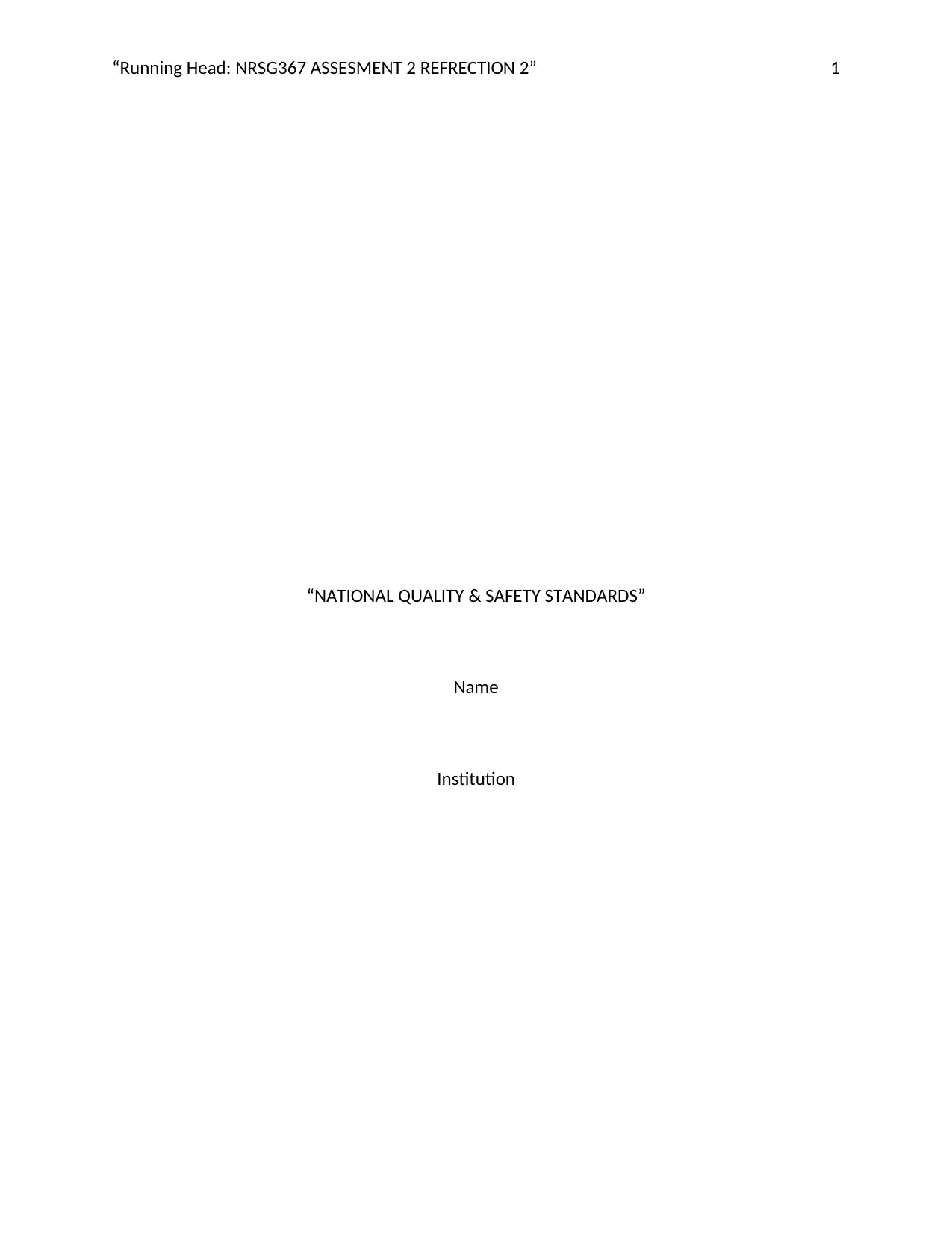
“Running Head: NRSG367 ASSESMENT 2 REFRECTION 2” 1
“NATIONAL QUALITY & SAFETY STANDARDS”
Name
Institution
“NATIONAL QUALITY & SAFETY STANDARDS”
Name
Institution
Paraphrase This Document
Need a fresh take? Get an instant paraphrase of this document with our AI Paraphraser
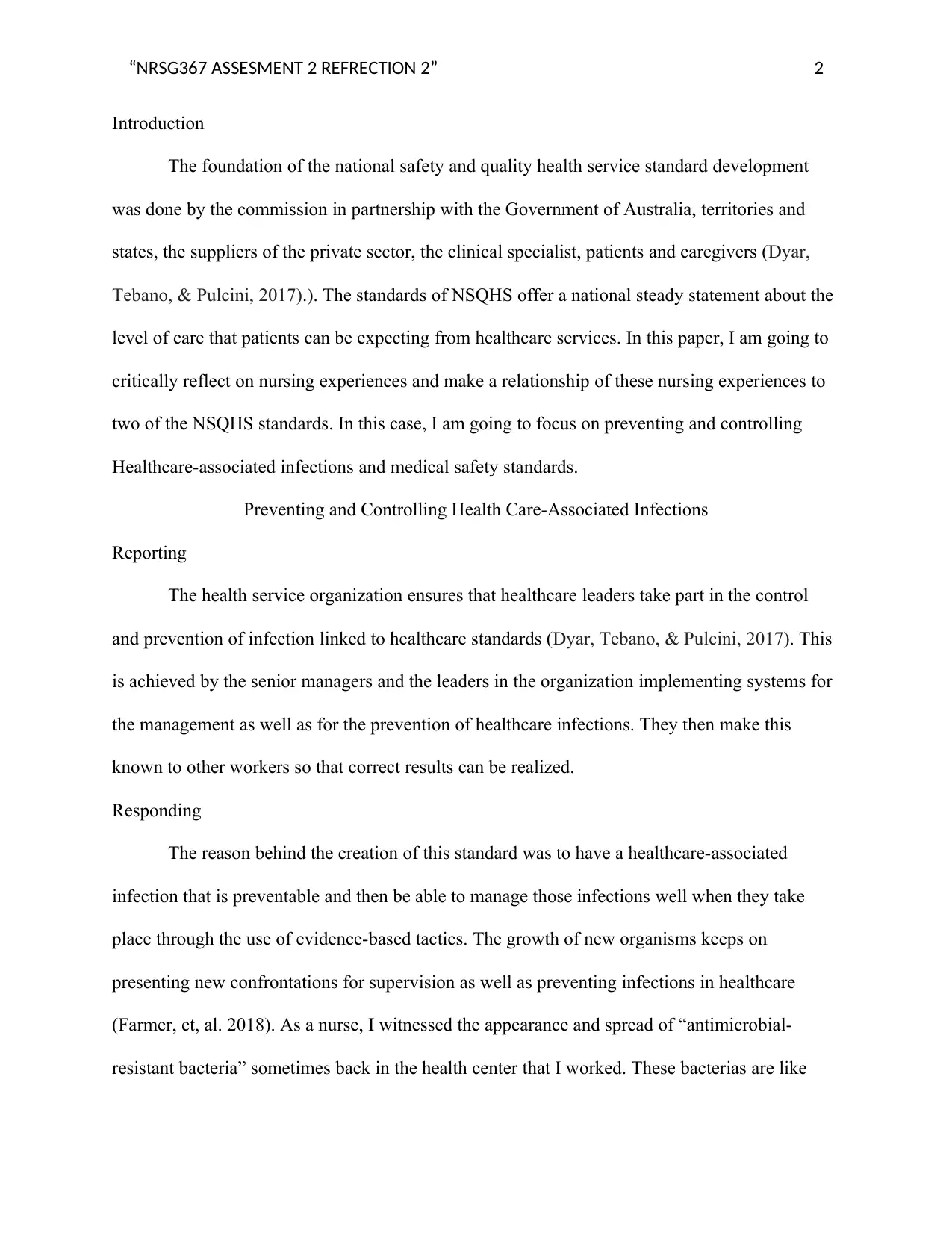
“NRSG367 ASSESMENT 2 REFRECTION 2” 2
Introduction
The foundation of the national safety and quality health service standard development
was done by the commission in partnership with the Government of Australia, territories and
states, the suppliers of the private sector, the clinical specialist, patients and caregivers (Dyar,
Tebano, & Pulcini, 2017).). The standards of NSQHS offer a national steady statement about the
level of care that patients can be expecting from healthcare services. In this paper, I am going to
critically reflect on nursing experiences and make a relationship of these nursing experiences to
two of the NSQHS standards. In this case, I am going to focus on preventing and controlling
Healthcare-associated infections and medical safety standards.
Preventing and Controlling Health Care-Associated Infections
Reporting
The health service organization ensures that healthcare leaders take part in the control
and prevention of infection linked to healthcare standards (Dyar, Tebano, & Pulcini, 2017). This
is achieved by the senior managers and the leaders in the organization implementing systems for
the management as well as for the prevention of healthcare infections. They then make this
known to other workers so that correct results can be realized.
Responding
The reason behind the creation of this standard was to have a healthcare-associated
infection that is preventable and then be able to manage those infections well when they take
place through the use of evidence-based tactics. The growth of new organisms keeps on
presenting new confrontations for supervision as well as preventing infections in healthcare
(Farmer, et, al. 2018). As a nurse, I witnessed the appearance and spread of “antimicrobial-
resistant bacteria” sometimes back in the health center that I worked. These bacterias are like
Introduction
The foundation of the national safety and quality health service standard development
was done by the commission in partnership with the Government of Australia, territories and
states, the suppliers of the private sector, the clinical specialist, patients and caregivers (Dyar,
Tebano, & Pulcini, 2017).). The standards of NSQHS offer a national steady statement about the
level of care that patients can be expecting from healthcare services. In this paper, I am going to
critically reflect on nursing experiences and make a relationship of these nursing experiences to
two of the NSQHS standards. In this case, I am going to focus on preventing and controlling
Healthcare-associated infections and medical safety standards.
Preventing and Controlling Health Care-Associated Infections
Reporting
The health service organization ensures that healthcare leaders take part in the control
and prevention of infection linked to healthcare standards (Dyar, Tebano, & Pulcini, 2017). This
is achieved by the senior managers and the leaders in the organization implementing systems for
the management as well as for the prevention of healthcare infections. They then make this
known to other workers so that correct results can be realized.
Responding
The reason behind the creation of this standard was to have a healthcare-associated
infection that is preventable and then be able to manage those infections well when they take
place through the use of evidence-based tactics. The growth of new organisms keeps on
presenting new confrontations for supervision as well as preventing infections in healthcare
(Farmer, et, al. 2018). As a nurse, I witnessed the appearance and spread of “antimicrobial-
resistant bacteria” sometimes back in the health center that I worked. These bacterias are like
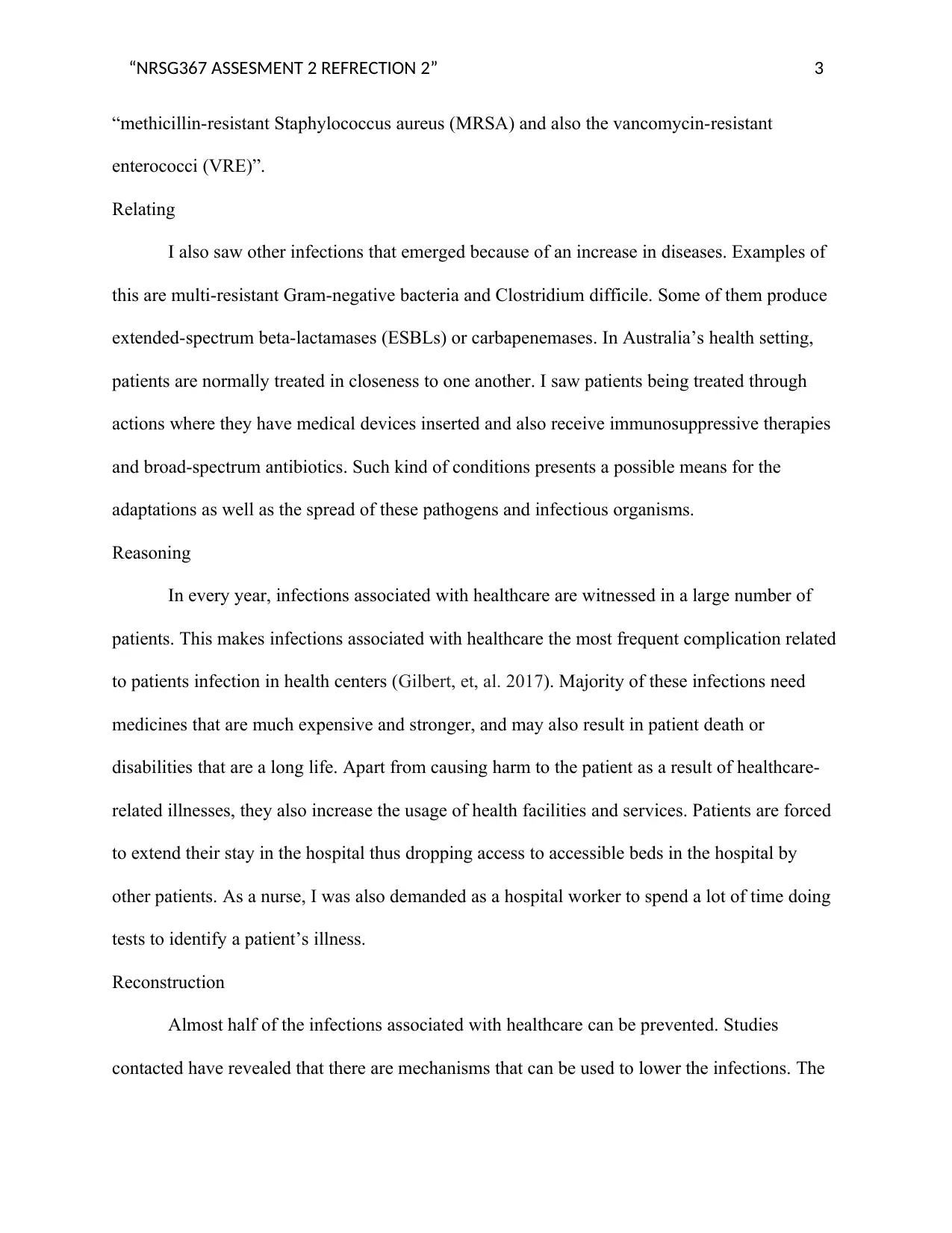
“NRSG367 ASSESMENT 2 REFRECTION 2” 3
“methicillin-resistant Staphylococcus aureus (MRSA) and also the vancomycin-resistant
enterococci (VRE)”.
Relating
I also saw other infections that emerged because of an increase in diseases. Examples of
this are multi-resistant Gram-negative bacteria and Clostridium difficile. Some of them produce
extended-spectrum beta-lactamases (ESBLs) or carbapenemases. In Australia’s health setting,
patients are normally treated in closeness to one another. I saw patients being treated through
actions where they have medical devices inserted and also receive immunosuppressive therapies
and broad-spectrum antibiotics. Such kind of conditions presents a possible means for the
adaptations as well as the spread of these pathogens and infectious organisms.
Reasoning
In every year, infections associated with healthcare are witnessed in a large number of
patients. This makes infections associated with healthcare the most frequent complication related
to patients infection in health centers (Gilbert, et, al. 2017). Majority of these infections need
medicines that are much expensive and stronger, and may also result in patient death or
disabilities that are a long life. Apart from causing harm to the patient as a result of healthcare-
related illnesses, they also increase the usage of health facilities and services. Patients are forced
to extend their stay in the hospital thus dropping access to accessible beds in the hospital by
other patients. As a nurse, I was also demanded as a hospital worker to spend a lot of time doing
tests to identify a patient’s illness.
Reconstruction
Almost half of the infections associated with healthcare can be prevented. Studies
contacted have revealed that there are mechanisms that can be used to lower the infections. The
“methicillin-resistant Staphylococcus aureus (MRSA) and also the vancomycin-resistant
enterococci (VRE)”.
Relating
I also saw other infections that emerged because of an increase in diseases. Examples of
this are multi-resistant Gram-negative bacteria and Clostridium difficile. Some of them produce
extended-spectrum beta-lactamases (ESBLs) or carbapenemases. In Australia’s health setting,
patients are normally treated in closeness to one another. I saw patients being treated through
actions where they have medical devices inserted and also receive immunosuppressive therapies
and broad-spectrum antibiotics. Such kind of conditions presents a possible means for the
adaptations as well as the spread of these pathogens and infectious organisms.
Reasoning
In every year, infections associated with healthcare are witnessed in a large number of
patients. This makes infections associated with healthcare the most frequent complication related
to patients infection in health centers (Gilbert, et, al. 2017). Majority of these infections need
medicines that are much expensive and stronger, and may also result in patient death or
disabilities that are a long life. Apart from causing harm to the patient as a result of healthcare-
related illnesses, they also increase the usage of health facilities and services. Patients are forced
to extend their stay in the hospital thus dropping access to accessible beds in the hospital by
other patients. As a nurse, I was also demanded as a hospital worker to spend a lot of time doing
tests to identify a patient’s illness.
Reconstruction
Almost half of the infections associated with healthcare can be prevented. Studies
contacted have revealed that there are mechanisms that can be used to lower the infections. The
⊘ This is a preview!⊘
Do you want full access?
Subscribe today to unlock all pages.

Trusted by 1+ million students worldwide
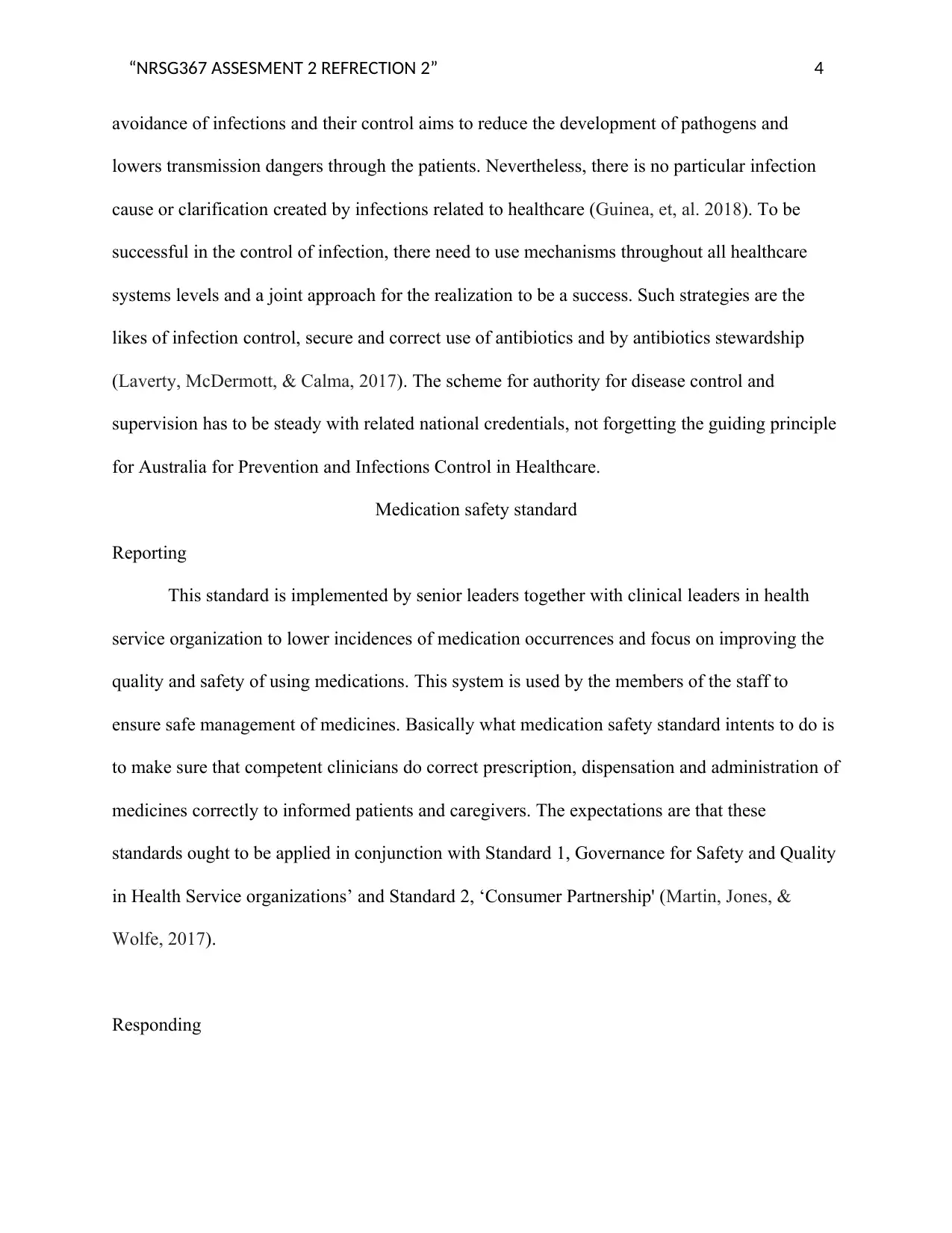
“NRSG367 ASSESMENT 2 REFRECTION 2” 4
avoidance of infections and their control aims to reduce the development of pathogens and
lowers transmission dangers through the patients. Nevertheless, there is no particular infection
cause or clarification created by infections related to healthcare (Guinea, et, al. 2018). To be
successful in the control of infection, there need to use mechanisms throughout all healthcare
systems levels and a joint approach for the realization to be a success. Such strategies are the
likes of infection control, secure and correct use of antibiotics and by antibiotics stewardship
(Laverty, McDermott, & Calma, 2017). The scheme for authority for disease control and
supervision has to be steady with related national credentials, not forgetting the guiding principle
for Australia for Prevention and Infections Control in Healthcare.
Medication safety standard
Reporting
This standard is implemented by senior leaders together with clinical leaders in health
service organization to lower incidences of medication occurrences and focus on improving the
quality and safety of using medications. This system is used by the members of the staff to
ensure safe management of medicines. Basically what medication safety standard intents to do is
to make sure that competent clinicians do correct prescription, dispensation and administration of
medicines correctly to informed patients and caregivers. The expectations are that these
standards ought to be applied in conjunction with Standard 1, Governance for Safety and Quality
in Health Service organizations’ and Standard 2, ‘Consumer Partnership' (Martin, Jones, &
Wolfe, 2017).
Responding
avoidance of infections and their control aims to reduce the development of pathogens and
lowers transmission dangers through the patients. Nevertheless, there is no particular infection
cause or clarification created by infections related to healthcare (Guinea, et, al. 2018). To be
successful in the control of infection, there need to use mechanisms throughout all healthcare
systems levels and a joint approach for the realization to be a success. Such strategies are the
likes of infection control, secure and correct use of antibiotics and by antibiotics stewardship
(Laverty, McDermott, & Calma, 2017). The scheme for authority for disease control and
supervision has to be steady with related national credentials, not forgetting the guiding principle
for Australia for Prevention and Infections Control in Healthcare.
Medication safety standard
Reporting
This standard is implemented by senior leaders together with clinical leaders in health
service organization to lower incidences of medication occurrences and focus on improving the
quality and safety of using medications. This system is used by the members of the staff to
ensure safe management of medicines. Basically what medication safety standard intents to do is
to make sure that competent clinicians do correct prescription, dispensation and administration of
medicines correctly to informed patients and caregivers. The expectations are that these
standards ought to be applied in conjunction with Standard 1, Governance for Safety and Quality
in Health Service organizations’ and Standard 2, ‘Consumer Partnership' (Martin, Jones, &
Wolfe, 2017).
Responding
Paraphrase This Document
Need a fresh take? Get an instant paraphrase of this document with our AI Paraphraser
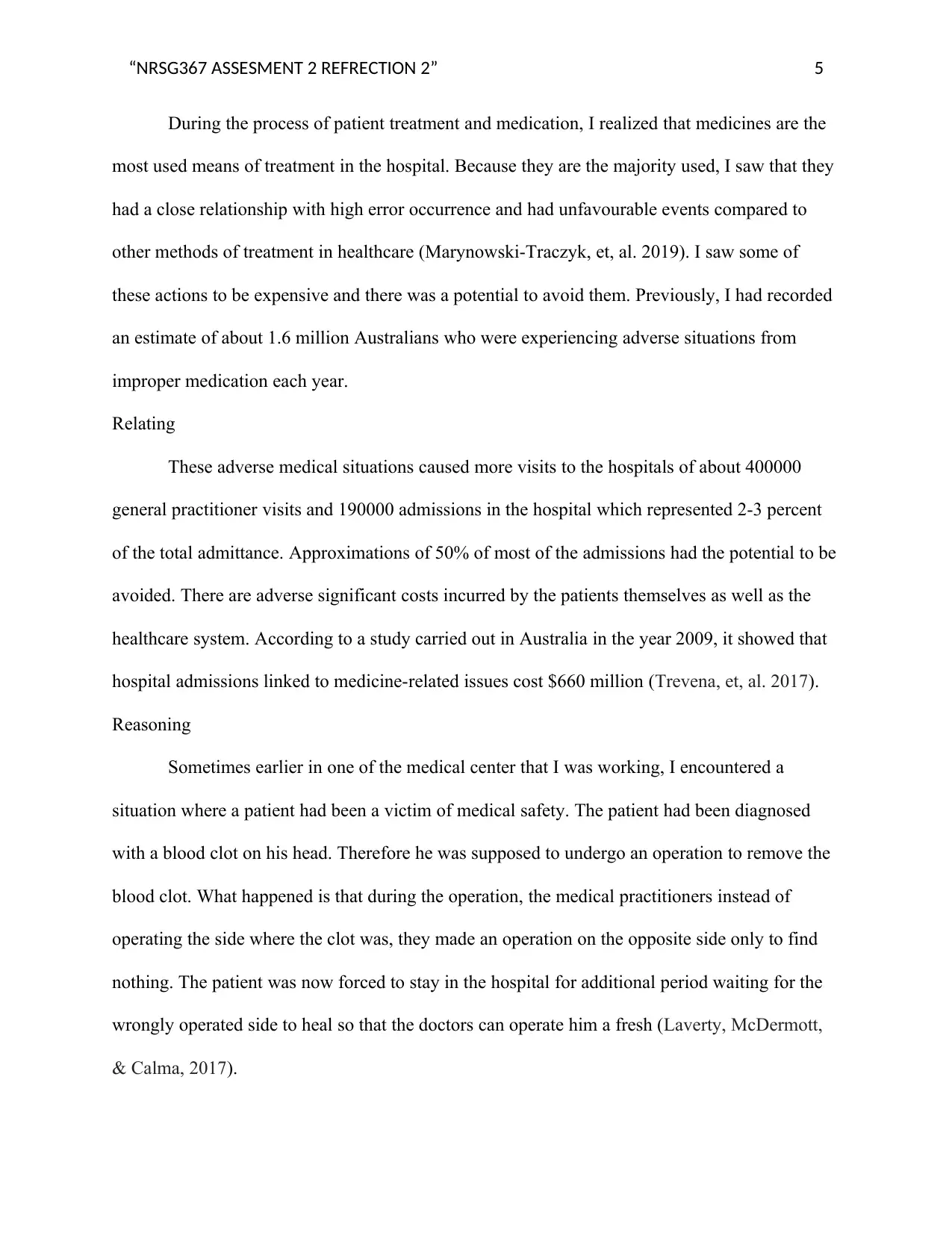
“NRSG367 ASSESMENT 2 REFRECTION 2” 5
During the process of patient treatment and medication, I realized that medicines are the
most used means of treatment in the hospital. Because they are the majority used, I saw that they
had a close relationship with high error occurrence and had unfavourable events compared to
other methods of treatment in healthcare (Marynowski-Traczyk, et, al. 2019). I saw some of
these actions to be expensive and there was a potential to avoid them. Previously, I had recorded
an estimate of about 1.6 million Australians who were experiencing adverse situations from
improper medication each year.
Relating
These adverse medical situations caused more visits to the hospitals of about 400000
general practitioner visits and 190000 admissions in the hospital which represented 2-3 percent
of the total admittance. Approximations of 50% of most of the admissions had the potential to be
avoided. There are adverse significant costs incurred by the patients themselves as well as the
healthcare system. According to a study carried out in Australia in the year 2009, it showed that
hospital admissions linked to medicine-related issues cost $660 million (Trevena, et, al. 2017).
Reasoning
Sometimes earlier in one of the medical center that I was working, I encountered a
situation where a patient had been a victim of medical safety. The patient had been diagnosed
with a blood clot on his head. Therefore he was supposed to undergo an operation to remove the
blood clot. What happened is that during the operation, the medical practitioners instead of
operating the side where the clot was, they made an operation on the opposite side only to find
nothing. The patient was now forced to stay in the hospital for additional period waiting for the
wrongly operated side to heal so that the doctors can operate him a fresh (Laverty, McDermott,
& Calma, 2017).
During the process of patient treatment and medication, I realized that medicines are the
most used means of treatment in the hospital. Because they are the majority used, I saw that they
had a close relationship with high error occurrence and had unfavourable events compared to
other methods of treatment in healthcare (Marynowski-Traczyk, et, al. 2019). I saw some of
these actions to be expensive and there was a potential to avoid them. Previously, I had recorded
an estimate of about 1.6 million Australians who were experiencing adverse situations from
improper medication each year.
Relating
These adverse medical situations caused more visits to the hospitals of about 400000
general practitioner visits and 190000 admissions in the hospital which represented 2-3 percent
of the total admittance. Approximations of 50% of most of the admissions had the potential to be
avoided. There are adverse significant costs incurred by the patients themselves as well as the
healthcare system. According to a study carried out in Australia in the year 2009, it showed that
hospital admissions linked to medicine-related issues cost $660 million (Trevena, et, al. 2017).
Reasoning
Sometimes earlier in one of the medical center that I was working, I encountered a
situation where a patient had been a victim of medical safety. The patient had been diagnosed
with a blood clot on his head. Therefore he was supposed to undergo an operation to remove the
blood clot. What happened is that during the operation, the medical practitioners instead of
operating the side where the clot was, they made an operation on the opposite side only to find
nothing. The patient was now forced to stay in the hospital for additional period waiting for the
wrongly operated side to heal so that the doctors can operate him a fresh (Laverty, McDermott,
& Calma, 2017).
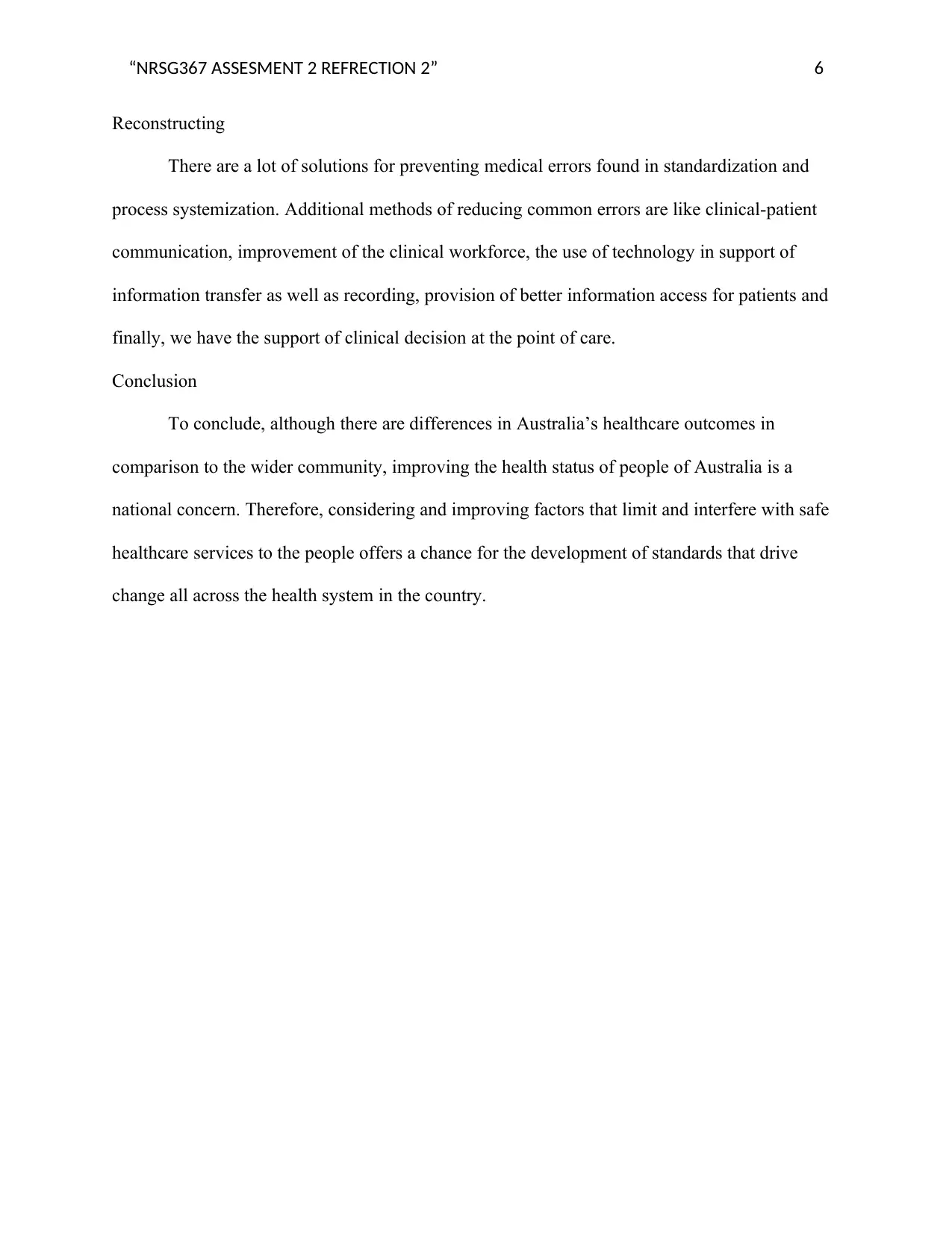
“NRSG367 ASSESMENT 2 REFRECTION 2” 6
Reconstructing
There are a lot of solutions for preventing medical errors found in standardization and
process systemization. Additional methods of reducing common errors are like clinical-patient
communication, improvement of the clinical workforce, the use of technology in support of
information transfer as well as recording, provision of better information access for patients and
finally, we have the support of clinical decision at the point of care.
Conclusion
To conclude, although there are differences in Australia’s healthcare outcomes in
comparison to the wider community, improving the health status of people of Australia is a
national concern. Therefore, considering and improving factors that limit and interfere with safe
healthcare services to the people offers a chance for the development of standards that drive
change all across the health system in the country.
Reconstructing
There are a lot of solutions for preventing medical errors found in standardization and
process systemization. Additional methods of reducing common errors are like clinical-patient
communication, improvement of the clinical workforce, the use of technology in support of
information transfer as well as recording, provision of better information access for patients and
finally, we have the support of clinical decision at the point of care.
Conclusion
To conclude, although there are differences in Australia’s healthcare outcomes in
comparison to the wider community, improving the health status of people of Australia is a
national concern. Therefore, considering and improving factors that limit and interfere with safe
healthcare services to the people offers a chance for the development of standards that drive
change all across the health system in the country.
⊘ This is a preview!⊘
Do you want full access?
Subscribe today to unlock all pages.

Trusted by 1+ million students worldwide
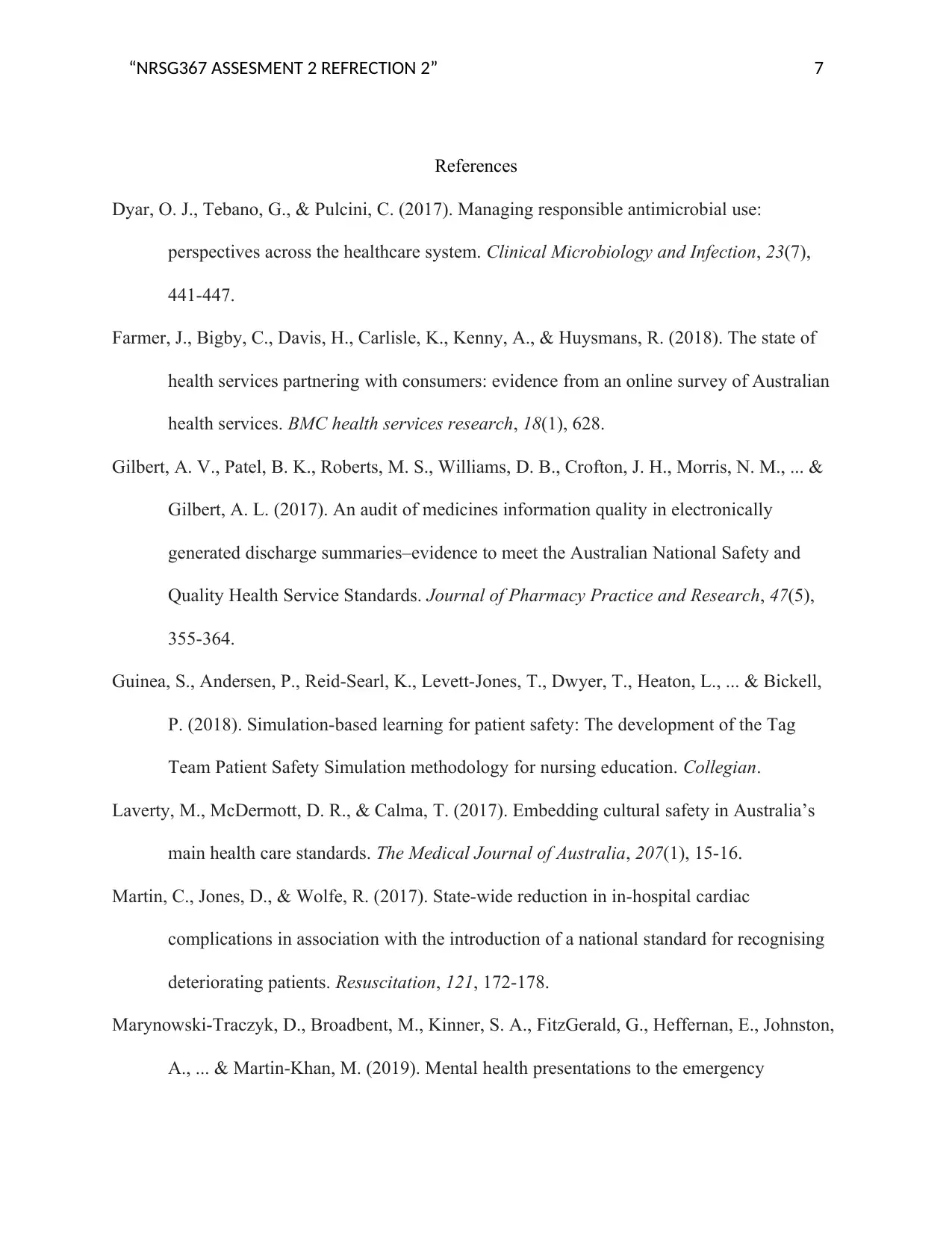
“NRSG367 ASSESMENT 2 REFRECTION 2” 7
References
Dyar, O. J., Tebano, G., & Pulcini, C. (2017). Managing responsible antimicrobial use:
perspectives across the healthcare system. Clinical Microbiology and Infection, 23(7),
441-447.
Farmer, J., Bigby, C., Davis, H., Carlisle, K., Kenny, A., & Huysmans, R. (2018). The state of
health services partnering with consumers: evidence from an online survey of Australian
health services. BMC health services research, 18(1), 628.
Gilbert, A. V., Patel, B. K., Roberts, M. S., Williams, D. B., Crofton, J. H., Morris, N. M., ... &
Gilbert, A. L. (2017). An audit of medicines information quality in electronically
generated discharge summaries–evidence to meet the Australian National Safety and
Quality Health Service Standards. Journal of Pharmacy Practice and Research, 47(5),
355-364.
Guinea, S., Andersen, P., Reid-Searl, K., Levett-Jones, T., Dwyer, T., Heaton, L., ... & Bickell,
P. (2018). Simulation-based learning for patient safety: The development of the Tag
Team Patient Safety Simulation methodology for nursing education. Collegian.
Laverty, M., McDermott, D. R., & Calma, T. (2017). Embedding cultural safety in Australia’s
main health care standards. The Medical Journal of Australia, 207(1), 15-16.
Martin, C., Jones, D., & Wolfe, R. (2017). State-wide reduction in in-hospital cardiac
complications in association with the introduction of a national standard for recognising
deteriorating patients. Resuscitation, 121, 172-178.
Marynowski-Traczyk, D., Broadbent, M., Kinner, S. A., FitzGerald, G., Heffernan, E., Johnston,
A., ... & Martin-Khan, M. (2019). Mental health presentations to the emergency
References
Dyar, O. J., Tebano, G., & Pulcini, C. (2017). Managing responsible antimicrobial use:
perspectives across the healthcare system. Clinical Microbiology and Infection, 23(7),
441-447.
Farmer, J., Bigby, C., Davis, H., Carlisle, K., Kenny, A., & Huysmans, R. (2018). The state of
health services partnering with consumers: evidence from an online survey of Australian
health services. BMC health services research, 18(1), 628.
Gilbert, A. V., Patel, B. K., Roberts, M. S., Williams, D. B., Crofton, J. H., Morris, N. M., ... &
Gilbert, A. L. (2017). An audit of medicines information quality in electronically
generated discharge summaries–evidence to meet the Australian National Safety and
Quality Health Service Standards. Journal of Pharmacy Practice and Research, 47(5),
355-364.
Guinea, S., Andersen, P., Reid-Searl, K., Levett-Jones, T., Dwyer, T., Heaton, L., ... & Bickell,
P. (2018). Simulation-based learning for patient safety: The development of the Tag
Team Patient Safety Simulation methodology for nursing education. Collegian.
Laverty, M., McDermott, D. R., & Calma, T. (2017). Embedding cultural safety in Australia’s
main health care standards. The Medical Journal of Australia, 207(1), 15-16.
Martin, C., Jones, D., & Wolfe, R. (2017). State-wide reduction in in-hospital cardiac
complications in association with the introduction of a national standard for recognising
deteriorating patients. Resuscitation, 121, 172-178.
Marynowski-Traczyk, D., Broadbent, M., Kinner, S. A., FitzGerald, G., Heffernan, E., Johnston,
A., ... & Martin-Khan, M. (2019). Mental health presentations to the emergency
Paraphrase This Document
Need a fresh take? Get an instant paraphrase of this document with our AI Paraphraser
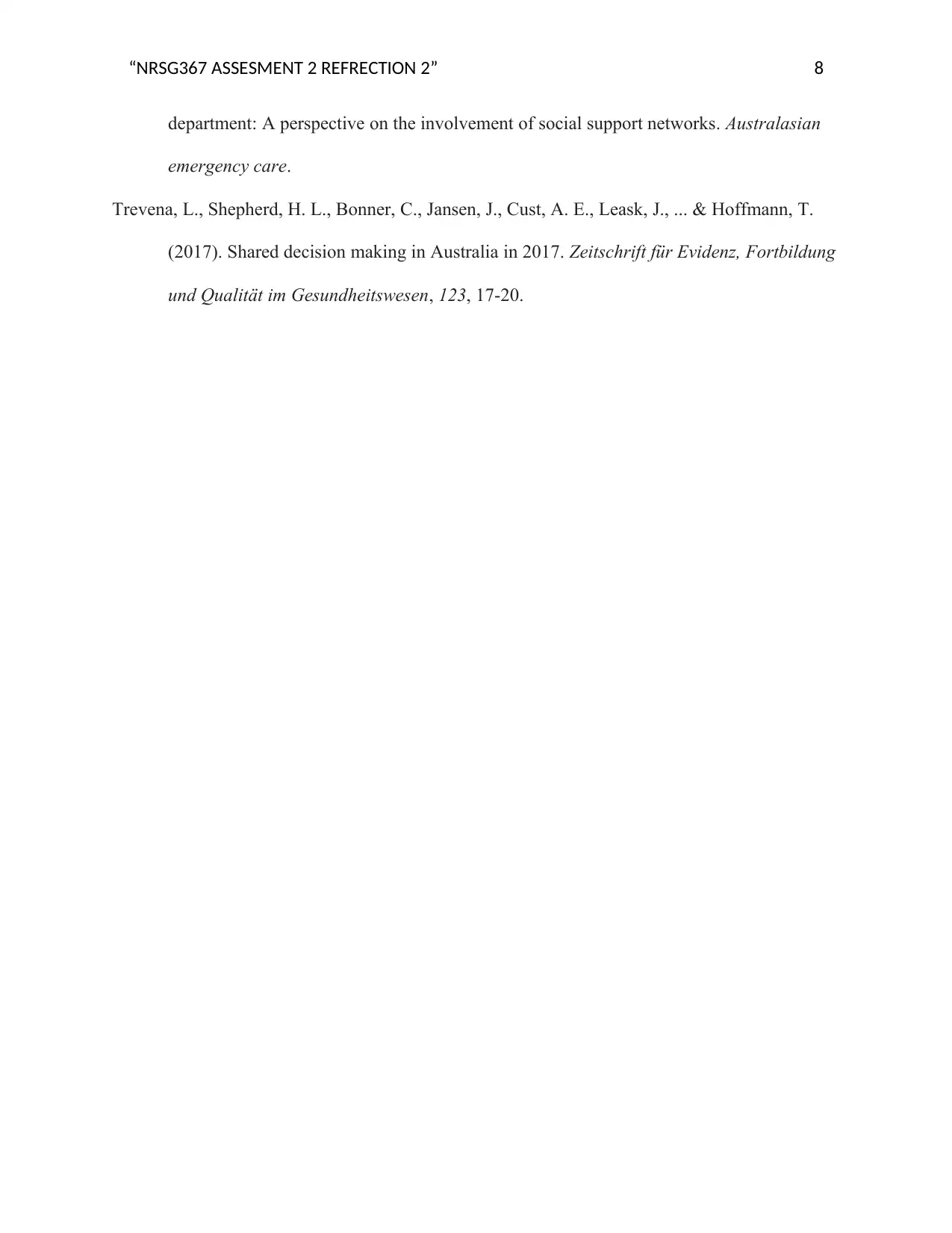
“NRSG367 ASSESMENT 2 REFRECTION 2” 8
department: A perspective on the involvement of social support networks. Australasian
emergency care.
Trevena, L., Shepherd, H. L., Bonner, C., Jansen, J., Cust, A. E., Leask, J., ... & Hoffmann, T.
(2017). Shared decision making in Australia in 2017. Zeitschrift für Evidenz, Fortbildung
und Qualität im Gesundheitswesen, 123, 17-20.
department: A perspective on the involvement of social support networks. Australasian
emergency care.
Trevena, L., Shepherd, H. L., Bonner, C., Jansen, J., Cust, A. E., Leask, J., ... & Hoffmann, T.
(2017). Shared decision making in Australia in 2017. Zeitschrift für Evidenz, Fortbildung
und Qualität im Gesundheitswesen, 123, 17-20.
1 out of 8
Related Documents
Your All-in-One AI-Powered Toolkit for Academic Success.
+13062052269
info@desklib.com
Available 24*7 on WhatsApp / Email
![[object Object]](/_next/static/media/star-bottom.7253800d.svg)
Unlock your academic potential
Copyright © 2020–2025 A2Z Services. All Rights Reserved. Developed and managed by ZUCOL.





